Welcome to our blog, where we dive into the fascinating world of Canada Greenhouse Farming! As concerns about food security and sustainable agriculture continue to grow, greenhouse farming has emerged as a revolutionary solution. In this series, we will explore the ins and outs of greenhouse farming in Canada, from its environmental benefits to its impact on local communities. Join us as we delve into the innovative techniques employed, the crops that thrive in these controlled environments, and the role of technology in maximizing yields.
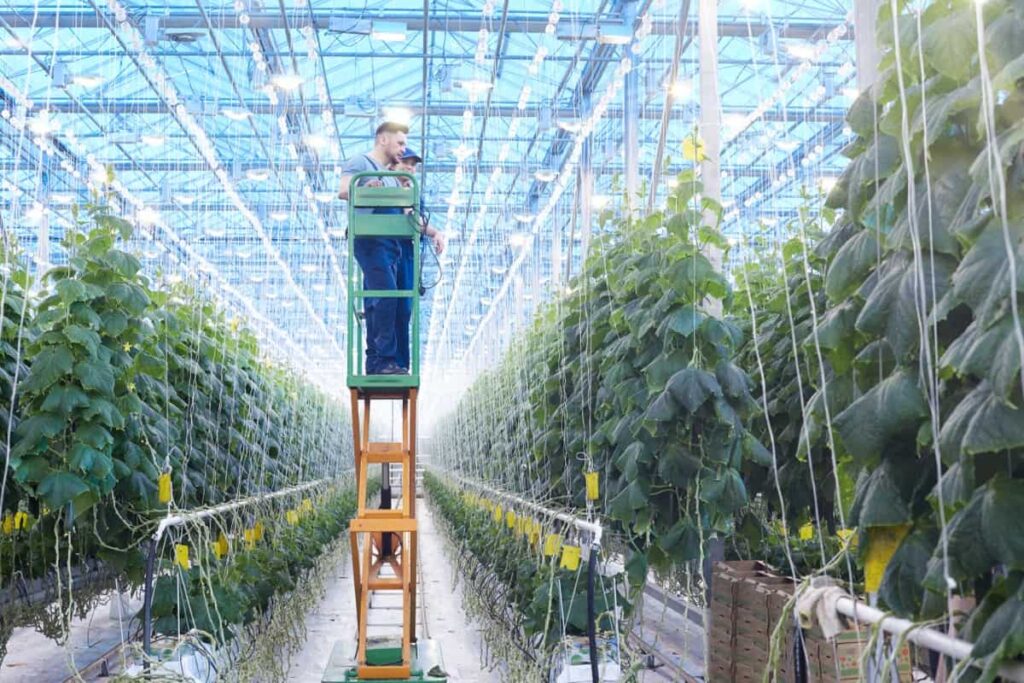
What is Greenhouse Farming in Canada?
Greenhouse farming in Canada refers to the practice of growing plants in controlled environments, using structures made of transparent materials like glass or plastic to create a greenhouse effect. This enables farmers to cultivate crops year-round, irrespective of Canada’s harsh climate. Greenhouses provide a controlled environment where temperature, humidity, light, and ventilation can be regulated, optimizing plant growth.
Canada’s greenhouse farming industry has grown significantly, with over 2,800 hectares of greenhouse space across the country. The sector contributes to the economy, providing employment opportunities and supplying a wide range of fresh produce, including tomatoes, cucumbers, peppers, lettuce, and herbs, to meet consumer demand.
Is Greenhouse Farming Profitable in Canada?
Greenhouse farming is a method of agriculture that uses artificial structures to create a controlled environment for plant growth. In Canada, it has gained popularity as a sustainable and profitable industry. Technological advancements have made greenhouses more efficient and productive, allowing farmers to export their products worldwide.
Location, costs, and market demand influence the profitability of greenhouse farming in Canada. Before starting a greenhouse farm, careful consideration should be given to suitable land, equipment, construction costs, and ongoing maintenance. While greenhouse farming offers year-round cultivation possibilities, planning and choosing appropriate crops are crucial for maximizing productivity.
How to Start a Greenhouse Farm in Canada
Starting a greenhouse farm in Canada involves several essential steps. Thorough research and planning are crucial, including understanding greenhouse farming techniques, crop options, market demand, and local regulations. A comprehensive business plan is essential to outline goals, financial projections, and marketing strategies.
Selecting a suitable location with access to necessary resources and choosing the right greenhouse structure based on budget and crop requirements is important. Compliance with legal and regulatory requirements, such as obtaining permits and adhering to environmental standards, is necessary. Crop selection should consider climate suitability and market demand.
Investing in essential greenhouse equipment, establishing sourcing methods, and developing operational and maintenance plans are crucial. Effective marketing and sales strategies, continuous learning, networking, and sound financial management are key to success. Starting a greenhouse farm in Canada requires dedication, hard work, and a commitment to sustainable agriculture. By following these steps, beginners can embark on a rewarding journey in the greenhouse farming industry.
In case you missed it: Canada Vegetable Planting Calendar: Month-wise Chart, Sowing Schedule, and Guide

Types of Greenhouses in Canada
In Canada, greenhouses come in various types designed to meet specific needs and climatic conditions. Some common types include Quonset greenhouses, which are cost-effective and have a curved, semi-circular structure; gable greenhouses, which provide vertical space for taller plants; gothic arch greenhouses, known for their arched roofs that shed snow effectively.
Dutch Venlo greenhouses, featuring high, pitched roofs and excellent light transmission; polyethylene film greenhouses, which are low-cost structures covered with durable plastic film for seasonal crop production; and glass greenhouses, made of glass panels that offer optimal light transmission and are ideal for high-value crops or ornamental plants.
Canada has greenhouse systems for growing produce, including vertical greenhouses, hanging greenhouses, inverted-pyramid greenhouses, traditional glass greenhouses, hoop houses, and tunnel greenhouses. Vertical greenhouses are the most common type, built on tiers that allow sunlight to penetrate deep into the plant’s roots. Hanging greenhouses are more expensive but offer a wider range of crop options, particularly for vegetables like peppers, lettuce, and herbs.
Inverted-pyramid greenhouses have a pyramid shape that allows more light to reach plants at the top, making them ideal for growing ornamental plants like roses or conifers. Traditional glass greenhouses, shaped like bells, can hold up to 1,000 plants but require regular maintenance and low yields. Hoop houses, unique to Canada, are large hoops covered in plastic or metal sheets filled with soil, allowing plants to grow around them.
Tunnel greenhouses, with long tunnels, take advantage of natural sunlight, resulting in higher yields and smaller plant sizes. The diversity in greenhouse types allows Canadian farmers to select the most suitable option based on their specific requirements. These greenhouses play a crucial role in enabling year-round cultivation of a wide range of crops, contributing to the agricultural diversity and food security of the country.
Greenhouse Farming Techniques in Canada
In Canada, greenhouse farming techniques have evolved to optimize crop production in controlled environments. Key techniques include hydroponics, which allows for soil-less cultivation with precise control over nutrient levels and water usage. Vertical farming maximizes production in limited space by utilizing vertical stacking and multiple levels of growing beds.
In case you missed it: How to Grow Leafy Green Vegetables in Hydroponics: A Step-by-step Growing Guide
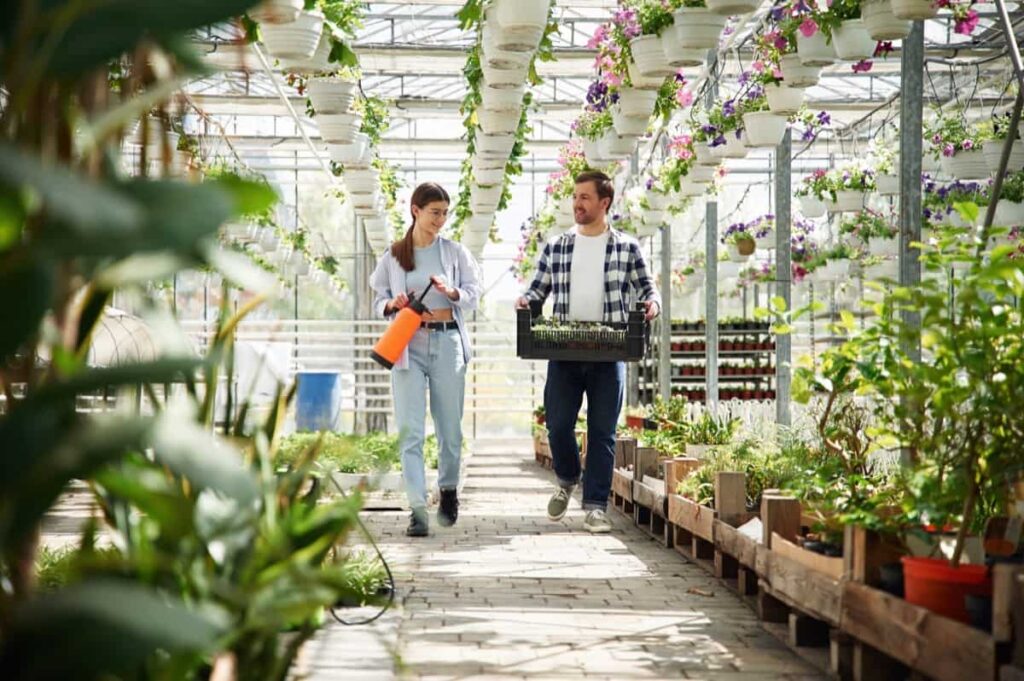
LED lighting provides customized light spectra, promoting plant growth and energy efficiency. Advanced climate control systems regulate temperature, humidity, CO2 levels, and ventilation to create optimal growing conditions. Integrated Pest Management (IPM) techniques minimize pesticide use through biological control methods.
High-tech sensors and automation enable real-time monitoring and control of parameters like temperature and irrigation, improving efficiency and reducing resource wastage. Controlled Environment Agriculture (CEA) combines various technologies for year-round cultivation and higher yields. These techniques highlight the industry’s focus on productivity, sustainability, and profitability.
Sustainable Practices in Canadian Greenhouse Farming
- Water Conservation: Efficient irrigation systems, such as drip or recirculating systems, reduce water usage and minimize runoff.
- Energy Efficiency: Implementing energy-efficient technologies like LED lighting, curtains, and insulated structures helps reduce energy consumption.
- Renewable Energy: Integrating renewable energy sources like solar panels or wind turbines can offset greenhouse energy demands and reduce reliance on non-renewable resources.
- Integrated Pest Management (IPM): By utilizing biological controls, beneficial insects, and crop rotation, greenhouse farmers can minimize pesticide use and promote natural pest control.
- Waste Management: Proper waste management, including composting and recycling, reduces environmental impact and can lead to cost savings.
- Efficient Nutrient Management: Precise nutrient monitoring and application techniques optimize plant nutrient uptake, minimizing fertilizer runoff and environmental pollution.
- Biodiversity Preservation: Maintaining biodiversity through native plants, hedgerows, and insect habitats promotes a healthy ecosystem within and around the greenhouse.
- Carbon Footprint Reduction: Implementing practices to reduce greenhouse gas emissions, such as carbon capture technologies or utilizing biofuels, contributes to a lower carbon footprint.
- Continuous Research and Innovation: Staying informed about the latest sustainable farming practices and technological advancements and participating in research programs helps greenhouse farmers stay at the forefront of sustainable agriculture.
Canada Greenhouse Vegetable Production
- In 2019, Canada witnessed a flourishing greenhouse vegetable industry with a total production of approximately 1.3 million tonnes. Among the various greenhouse vegetable crops, cucumbers held the highest significance, contributing 42% to the total production with around 550,000 tonnes.
- Tomatoes followed closely, comprising 36% of the production and approximately 470,000 tonnes. Bell peppers accounted for a smaller portion, representing 9% of the greenhouse vegetable production, which equated to about 120,000 tonnes. The remaining 13% comprised other vegetable crops like lettuce, eggplant, and herbs.
- Canada used around 3,000 hectares of greenhouse area for vegetable cultivation to support this extensive production. The greenhouse vegetable industry was a significant employer, providing job opportunities for approximately 22,000 people in 2019.
- Furthermore, the industry thrived as an exporter, with greenhouse vegetable exports reaching over $850 million in the same year. Canadian greenhouse vegetable products found markets in various countries, including the United States, Japan, and Europe.
- The economic impact of the greenhouse vegetable industry on Canada is substantial, generating significant revenue and fostering local community development.
- The industry’s focus on key crops such as cucumbers, tomatoes, and bell peppers, combined with its export-oriented approach, has resulted in remarkable production volumes and economic benefits.
- As the demand for fresh and locally grown produce continues to rise, the Canadian greenhouse vegetable industry remains poised for sustained growth and continued success.
In case you missed it: Sustainable Greenhouse Farming: The Future of Agriculture
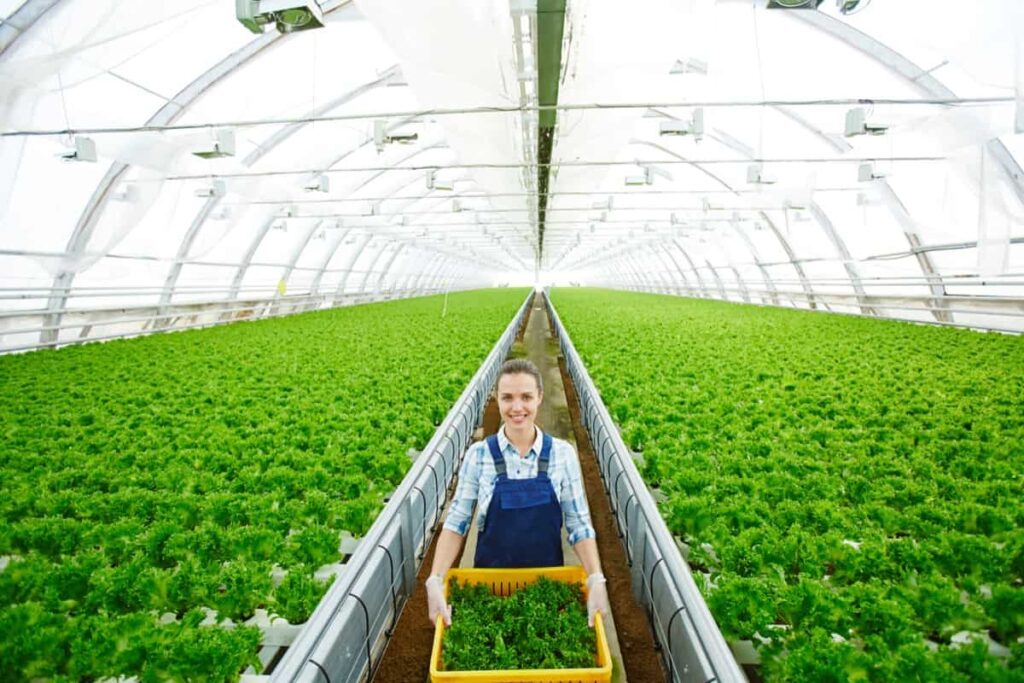
Climate Control Systems for Canadian Greenhouses
Temperature Control: Greenhouses employ heating and cooling systems to maintain the desired temperature range for plant growth. Heating systems, such as boilers or radiant heaters, provide warmth during cold periods, while ventilation and evaporative cooling systems help regulate temperature during hot periods.
Humidity Control: Humidity levels are controlled to prevent excessive moisture buildup or dryness. Humidifiers and dehumidifiers adjust humidity levels as needed, creating a suitable environment for crop growth.
CO2 Enrichment: Greenhouses often utilize CO2 enrichment systems to increase carbon dioxide levels. This enhances photosynthesis and promotes plant growth, especially in enclosed environments where natural CO2 levels may be limited.
Ventilation: Adequate ventilation is crucial to regulate airflow, removing excess heat and humidity, and provide fresh air exchange. Ventilation systems, including fans and louvers, ensure proper air circulation within the greenhouse.
Shading Systems: Shading systems, such as shade cloths or automated screens, help control light levels and prevent excessive heat buildup, particularly during the summer months.
Light Control: Greenhouses employ light control systems to manage the duration and intensity of light exposure. This can include using artificial lighting, light-diffusing materials, or shade systems to optimize photosynthesis and ensure proper plant development.
Environmental Sensors: Temperature, humidity, light, and CO2 sensors are integrated into climate control systems. These sensors provide real-time data to adjust and maintain optimal growing conditions.
Automation and Control: Many climate control systems are automated, allowing for precise control and adjustment of environmental parameters. This automation enables efficient management and reduces the need for constant manual monitoring.
Crop Selection for Canada Greenhouse Farming
Flowers: Popular flower crops suitable for Canadian greenhouses include roses, gerbera daisies, orchids, and chrysanthemums. These crops are known for their aesthetic appeal and have high market demand.
Fruits: Berries such as strawberries, raspberries, and blueberries are well-suited for greenhouse cultivation in Canada. They benefit from the controlled environment, producing higher yields and extending the growing season.
In case you missed it: How to Maximize Profit in Greenhouse Farming: Take an Advantage of Future Farming
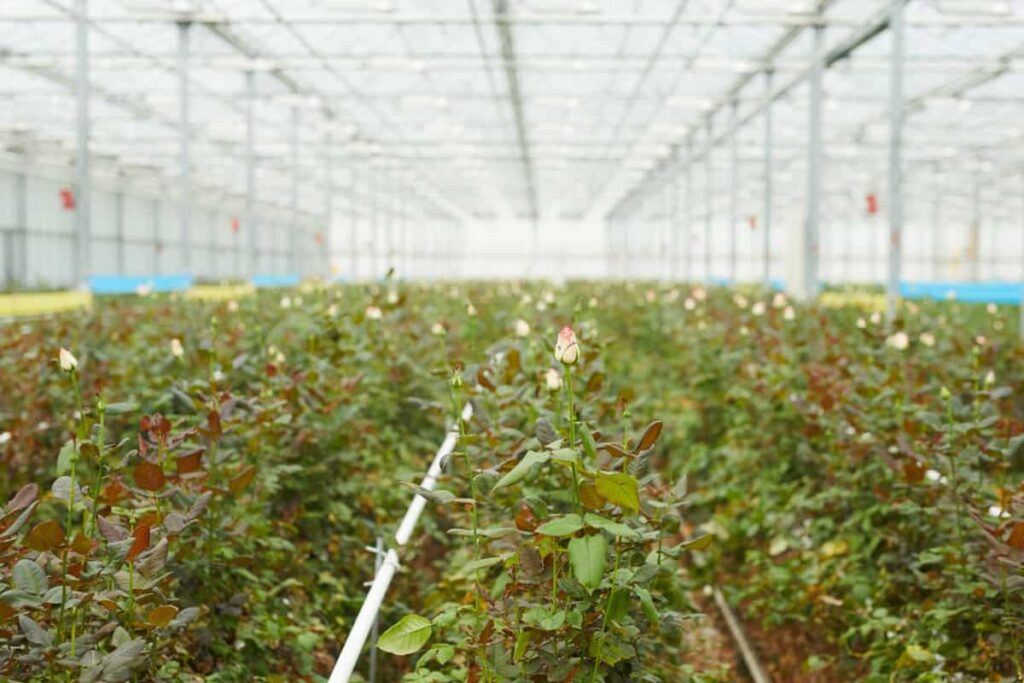
Tomatoes: Tomatoes are one of Canada’s most widely grown greenhouse vegetable crops. They thrive in a controlled environment, providing consistent production and high-quality fruits throughout the year.
Cucumbers: Cucumbers are another popular vegetable crop for Canadian greenhouses. With proper trellising and support, greenhouse-grown cucumbers produce abundant, straight fruits with fewer disease and pest issues than field cultivation.
Peppers: Bell peppers, including red, yellow, and green varieties, are well-suited for greenhouse cultivation. Greenhouse-grown peppers have higher yields, extended growing seasons, and uniform fruit quality.
Leafy Greens: Lettuce, spinach, and herbs like basil and parsley are suitable crops for Canadian greenhouses. Controlled environments offer ideal conditions for consistent growth, producing high-quality, fresh leafy greens.
Cucamelons: Cucamelons, also known as Mexican sour gherkins or “mouse melons,” are gaining popularity in Canadian greenhouses. These small, grape-sized fruits resemble tiny watermelons with a refreshing, tangy flavor.
Microgreens: Microgreens, including arugula, radish, and kale, are increasingly cultivated in Canadian greenhouses. These nutrient-rich young greens are harvested early and sought after by chefs and health-conscious consumers.
Pest and Disease Management in Canadian Greenhouse Farms
Pest and disease management is essential for Canadian greenhouse farms to maintain crop health and productivity. Common practices include biological control, Integrated Pest Management (IPM), sanitation, crop rotation, monitoring, quarantine, resistant varieties, proper irrigation, pesticide use, and training. These practices help prevent pests and diseases, reduce disease pressure, and minimize environmental impact. By implementing these practices, greenhouse farms can ensure crop health and productivity.
Greenhouse Automation Technologies in Canada
Greenhouse automation technologies significantly improve efficiency and productivity in Canadian greenhouse farming. Key automation technologies include climate control systems, irrigation and water management, lighting control, nutrient delivery systems, and data monitoring and analysis.
These systems optimize energy consumption, reduce waste, and enhance crop quality and productivity. These technologies reduce operational costs and contribute to environmental sustainability, making Canadian greenhouse farming a more viable and responsible industry.
Government Regulations for Greenhouse Farming in Canada
Government regulations are essential for Canada’s greenhouse farming compliance, safety, and sustainability. These regulations cover permits and licenses for water usage, land use, environmental impact assessments, pesticide application, food safety and quality assurance, labor and employment, zoning and land use, import and export regulations, and research and innovation support. By adhering to these regulations, greenhouse farmers contribute to environmental sustainability, consumer safety, and the development of a responsible agricultural sector.
In case you missed it: Farming Business Plan PDF: for Poultry, Livestock, Agriculture, Horticulture, Greenhouse, and Hydroponic
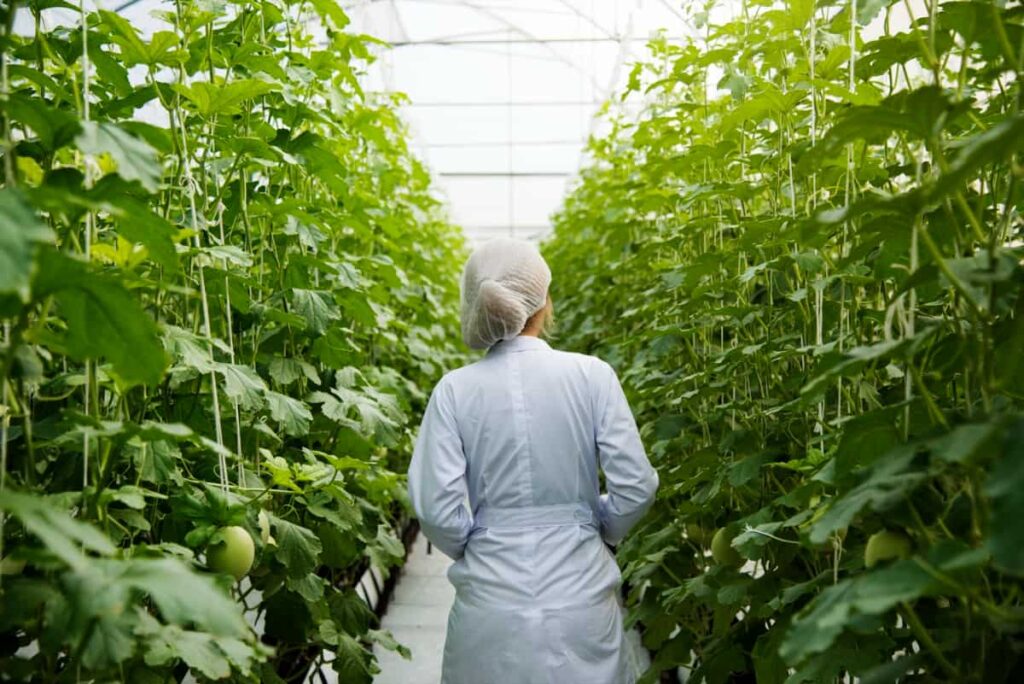
Market Trends and Opportunities in Canadian Greenhouse Farming
The agricultural industry in Canada is facing several challenges and uncertainties. However, there are also opportunities for agricultural producers and processors to navigate these challenges and thrive in the market.
The key trends in 2022 include inflation and interest rates, ongoing supply chain challenges, labor shortages, supply-demand imbalances, and shifting consumer demand for food products to help gain demand for Greenhouse Farming and automation. Despite the difficulties, there is optimism that the agriculture and food industry in Canada can become stronger and more resilient through innovation and sound risk management strategies.
Conclusion
Greenhouse farming in Canada offers numerous advantages, including extended growing seasons, controlled environments, and increased crop yields. It plays a significant role in the country’s agriculture sector, enhancing food production, promoting sustainability, and supporting economic growth.
- Crops Grown in Summer Season: Best Choices for Summer Gardening
- Organic Pest Control for Tomato Farming
- How to Maximize Sheep Farming Profit
- Broccoli Varieties: Choosing the Right Cultivars for Your Farm
- How to Raise Pigs in Your Own Backyard: A Comprehensive Guide
- Budget Friendly Sheep Shed Ideas: Cheap and Low-Cost Tips
- How Much Do Cattle Farmers Make: Revenue Streams in Cattle Farming
- Management Pests and Diseases in Your Cotton Field
- Sheep Farming Business Plan for Beginners
- Aquaponic Farming at Home: A Step-By-Step Guide
- Profitable Village Farming Business Ideas in 2024
- High-Yield Aquaculture: Fast-Growing Fish for Farming
- Effective Fish Pond Construction Techniques for Beginners
- Irrigation and Water Management in Pineapple Farming
- Blossom to Harvest: Mastering Flowering and Pollination in Papaya Farming
- Pig Fattening Essentials: From Selection to Sale for Beginners
- Raising Wagyu Cattle: A Complete Guide for Premium Beef Production
- Soil Types and Their Water Holding Capacity
- Optimizing Irrigation Schedules for Coconut Groves for Enhanced Yield
- Espresso Your Garden: Coffee Grounds for Healthier Acid-Loving Plants
- The Best Soil Mix for Snake Plants: How to Mix Your Own Snake Plant Soil
- Green Thumb Success: Expert Tips for Cultivating Greenhouse Beans All Year Round
- Bloom All Year Round: The Ultimate Guide to Indoor Hyacinth Care
- Eco-Friendly Gardening: How to Make Liquid Fertilizer from Kitchen Waste
- Ultimate Guide to Grow Anise in Pots: Explore Seed Propagation to Harvesting
- Guide to Raising Chester White Pigs: Discover Breed Facts to Growth Management
- Mastering the Elegance: The Ultimate Guide to Weeping Cherry Tree Care, Planting, and Maintenance
- Ultimate Guide to Planting Garlic in Grow Bags: Growing Strategies for Beginners
- How to Fix Spider Plant Leaf-Related Problems: Natural and Organic Remedies
- 10 Reasons Why Your Tulsi Plant is Shedding Leaves: Home Remedies and Solutions
- Optimizing Growth and Yield: The Advantages of Palm Bunch Ash Fertilizer
- Utilizing Neem Oil Extract as a Natural Pesticide for Hydrangea
- From Soil to Harvest: Various Ways in Which Farmers Can Use AI Tools
- Steps to Encourage and Induce Citrus Flowers: A Comprehensive Guide
- How to Fix Snake Plant Leaf-Related Issues: Natural and Organic Remedies
- Transform Your Garden into a Fragrant Oasis with Raat Ki Rani (Night Blooming Jasmine)
